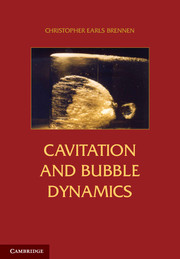4 - Dynamics of Oscillating Bubbles
Published online by Cambridge University Press: 05 October 2013
Summary
Introduction
The focus of the two preceding chapters was on the dynamics of the growth and collapse of a single bubble experiencing one period of tension. In this chapter we review the response of a bubble to a continuous, oscillating pressure field. Much of the material comes within the scope of acoustic cavitation, a subject with an extensive literature that is reviewed in more detail elsewhere (Flynn 1964; Neppiras 1980; Plesset and Prosperetti 1977; Prosperetti 1982,1984; Crum 1979; Young 1989). We include here a brief summary of the basic phenomena.
One useful classification of the subject uses the magnitude of the bubble radius oscillations in response to the imposed fluctuating pressure field. Three regimes can be identified:
For very small pressure amplitudes the response is linear. Section 4.2 contains the first step in any linear analysis, the identification of the natural frequency of an oscillating bubble.
Due to the nonlinearities in the governing equations, particularly the Rayleigh-Plesset Equation (2.12), the response of a bubble will begin to be affected by these nonlinearities as the amplitude of oscillation is increased. Nevertheless the bubble may continue to oscillate stably. Such circumstances are referred to as “stable acoustic cavitation” to distinguish them from those of the third regime described below. Several different nonlinear phenomena can affect stable acoustic cavitation in important ways. Among these are the production of subharmonics, the phenomenon of rectified diffusion, and the generation of Bjerknes forces. Each of these is described in greater detail later in the chapter.
…
- Type
- Chapter
- Information
- Cavitation and Bubble Dynamics , pp. 89 - 109Publisher: Cambridge University PressPrint publication year: 2013

